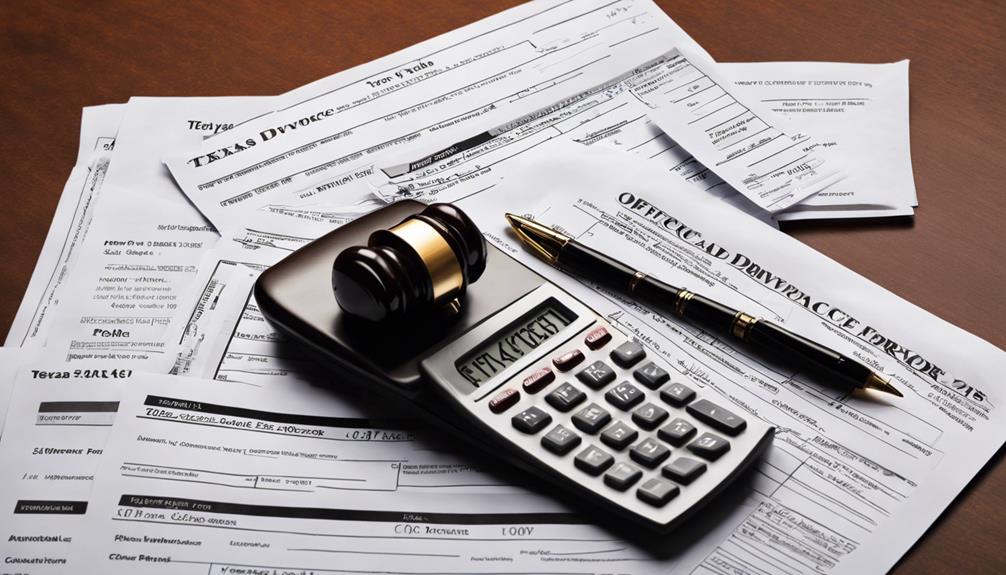When looking into the steps for obtaining a divorce in Maryland, it is interesting to point out that the state boasts one of the lowest divorce rates in the nation.
However, understanding the five essential steps to navigate through the divorce proceedings is crucial. From meeting residency requirements to finalizing the divorce process, each step plays a significant role in ensuring a smooth transition.
Let's explore these steps further to gain a comprehensive understanding of what it takes to navigate a divorce in Maryland.
Key Takeaways
- Verify Maryland residency for divorce filing.
- Decide between uncontested and contested divorce.
- Complete and file required divorce forms accurately.
- Ensure proper service of divorce papers for legal notification.
Residency and Jurisdiction Requirements
Understanding residency and jurisdiction requirements is crucial when considering a divorce in Maryland. To file for divorce in Maryland, at least one party must be a resident of the state. The residency duration needed varies based on where the grounds for divorce took place. If the grounds for divorce occurred within Maryland, current residency in the state is required. However, if the grounds for divorce originated outside Maryland, a typical requirement is a six-month residency. Specific details regarding residency prerequisites can be located in Md. Code, Family Law § 7-101.
Ensuring that both parties meet the necessary residency criteria is fundamental before initiating divorce proceedings in Maryland. It's essential to verify that the individual seeking a divorce meets the residency requirements laid out by the state's laws. Failure to meet these prerequisites could result in delays or complications in the divorce process. Therefore, understanding and fulfilling the residency and jurisdiction mandates are pivotal steps in navigating a divorce in Maryland successfully.
Choosing Contested or Uncontested Divorce

When considering divorce in Maryland, the decision between a contested or uncontested divorce hinges on the level of cooperation and agreement between spouses. An uncontested divorce occurs when both parties can amicably settle all issues without court intervention, leading to a quicker and more cost-effective process. On the other hand, a contested divorce involves disagreements that require legal resolution, leading to a longer and more complex procedure. In uncontested divorces, emotional stress and conflict are typically minimized compared to contested divorces, where disputes over child custody, alimony, and property division can heighten tensions. The choice between these two options ultimately depends on the ability of the spouses to work together and find common ground. Below is a table highlighting the key differences between contested and uncontested divorces:
| Aspect | Uncontested Divorce | Contested Divorce |
|---|---|---|
| Resolution Speed | Quick and efficient | Lengthy and time-consuming |
| Emotional Stress | Minimal due to cooperation | High due to disagreements |
| Court Involvement | Limited to finalizing paperwork | Involvement required for dispute resolution |
| Disputes | Rare, usually resolved amicably | Common, requiring legal intervention |
| Cost | Generally lower due to less legal involvement | Higher due to extended legal proceedings |
Gathering and Filing Divorce Forms
To efficiently initiate the divorce process in Maryland, start by securing the required forms for filing, including the Complaint for Absolute Divorce form, Dom.Rel. 20. These forms are essential for formally beginning the legal proceedings.
It's crucial to ensure accuracy when filling out additional court documents such as the Property Settlement Agreement and Financial Statement. Once all forms are completed, they should be filed at the Civil Desk in the Circuit Court where you currently reside.
If financial assistance is needed for filing, consider requesting a waiver of prepayment of fees. It's important to note that the court will decide on the fee waiver request before you can proceed with the divorce process.
For further assistance, the Maryland Court Help Center can provide additional guidance and support throughout the filing process. Remember, seeking legal advice from a lawyer specializing in Family Law can also be beneficial when filing for divorce, especially in matters related to Spousal Support.
Serving Divorce Papers

Properly serving divorce papers in Maryland is a critical step to notify the spouse about the ongoing legal proceedings. When serving divorce papers, it is crucial to follow Maryland's specific service requirements to ensure that the spouse is properly informed of the divorce process. There are various methods of serving divorce papers in Maryland, including Certified Mail, Sheriff, or a Private Process Server. Each method has its own procedures and implications, so it is essential to choose the most suitable option for your situation. After serving the divorce papers, it is necessary to file documentation, such as an Affidavit of Service, with the court to confirm that the papers were served correctly. Failure to serve divorce papers accurately may lead to delays or complications in the divorce process, underscoring the importance of adhering to the state's service requirements.
| Method of Service | Description |
|---|---|
| Certified Mail | Sending divorce papers through certified mail. |
| Sheriff | Having the sheriff deliver the papers in person. |
| Private Process Server | Hiring a private individual to serve the papers. |
| Affidavit of Service | Document filed with the court as proof of service. |
Finalizing the Divorce Process
Having successfully served the divorce papers in Maryland, the next step in the process is finalizing the divorce by attending court hearings to address outstanding issues and obtaining the final divorce decree.
To ensure a smooth finalization process, consider the following steps:
- Attend Court Hearings: It's crucial to participate in court hearings to resolve any remaining disputes and finalize the divorce legally.
- Obtain the Divorce Decree: The divorce decree is the official court order that marks the end of your marriage. This document is essential for officially concluding the divorce process.
- Update Legal Documents: After obtaining the divorce decree, update all relevant legal documents such as your driver's license, social security card, and passport with your new marital status to reflect the finalized divorce.
If you have a marital settlement agreement in place, make sure to follow specific steps outlined in the agreement. Seek legal assistance from resources like Maryland's Family Court Help Centers or Maryland Legal Aid if needed to navigate the finalization process effectively and ensure all legal aspects are correctly addressed.
Frequently Asked Questions
How Long Do You Have to Be Separated in Maryland to Get a Divorce?
We must be separated for a continuous 6 months in Maryland to qualify for a no-fault divorce based on separation. This period starts when we live separately with the intention of ending the marriage.
What Is the Fastest Way to Get a Divorce in Maryland?
The fastest way to get a divorce in Maryland is through mutual consent, where both parties agree on all terms beforehand. This streamlines the process, leading to a quicker resolution compared to other grounds for divorce, ultimately benefiting both spouses.
How Much Does It Cost to File for a Divorce in the State of Maryland?
Filing for a divorce in Maryland typically costs around $165, but additional expenses like court fees, legal representation, and mediation can vary. If affordability is a concern, income-based fee waivers may be available.
What Are Grounds for Immediate Divorce in Maryland?
We can get an immediate divorce in Maryland based on mutual consent, irreconcilable differences, or a 6-month separation. A settlement agreement or stating unresolved conflicts is needed. No waiting period is required if the grounds are met.
Are the Steps to Get a Divorce in Maryland Similar to the Steps in Florida?
The process of getting a divorce in Maryland and getting a divorce in Florida without a spouse differs slightly. In Maryland, one must meet residency requirements, file for divorce, and attend a hearing. In Florida, the process is similar but may involve additional steps depending on the circumstance of getting divorce in Florida without spouse.
Conclusion
In Maryland, navigating the necessary steps to get a divorce can be a challenging and emotional journey. From meeting residency requirements to finalizing the divorce process, it's important to approach each step with patience and diligence.
Remember, the key to a successful divorce in Maryland lies in understanding the grounds, filing the paperwork correctly, and ultimately, achieving closure through the legal process. Stay strong, stay informed, and stay focused on moving forward.










